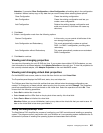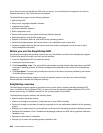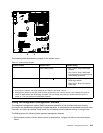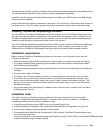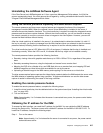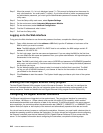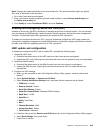
• DIMM error assistance. The Unied Extensible Firmware Interface (UEFI) disables a failing DIMM that is
detected during POST, and the IMM lights the associated system error LED and the failing DIMM error LED.
• System-event log (SEL).
• ROM-based IMM rmware ash updates.
• Auto Boot Failure Recovery (ABR).
• A virtual media key, which enables remote presence support (remote video, remote keyboard/mouse,
and remote storage).
• Nonmaskable interrupt (NMI) detection and reporting.
• Automatic Server Restart (ASR) when POST is not complete or the operating system hangs and the
operating system watchdog timer times-out. The IMM might be congured to watch for the operating
system watchdog timer and reboot the system after a timeout, if the ASR feature is enabled. Otherwise,
the IMM allows the administrator to generate a nonmaskable interrupt (NMI) by pressing an NMI button on
the system board for an operating-system memory dump. ASR is supported by IPMI.
• Intelligent Platform Management Interface (IPMI) Specication V2.0 and Intelligent Platform Management
Bus (IPMB) support.
• Invalid system conguration (CNFG) LED support.
• Serial port redirection over Telnet or SSH.
• Serial over LAN (SOL).
• Query power-supply input power.
• PECI 2 support.
• Power/reset control (power-on, hard and soft shutdown, hard and soft reset, schedule power control).
• Alerts (in-band and out-of-band alerting, PET traps - IPMI style, SNMP, e-mail).
• Operating-system failure blue screen capture.
• Command-line interface.
• Conguration save and restore.
• PCI conguration data.
• Boot sequence manipulation.
The IMM also provides the following remote server management capabilities through the OSA SMBridge
management utility program:
• Command-line interface (IPMI Shell)
The command-line interface provides direct access to server management functions through the IPMI
2.0 protocol. Use the command-line interface to issue commands to control the server power, view
system information, and identify the server. You can also save one or more commands as a text le and
run the le as a script.
• Serial over LAN
Establish a Serial over LAN (SOL) connection to manage servers from a remote location. You can remotely
view and change the UEFI settings, restart the server, identify the server, and perform other management
functions. Any standard Telnet client application can access the SOL connection.
IBM Advanced Settings Utility program
The IBM Advanced Settings Utility (ASU) program is an alternative to the UEFI Setup Utility program for
modifying UEFI settings. Use the ASU program online or out of band to modify UEFI settings from the
command line without the need to restart the system to access the UEFI Setup Utility program.
214 Hardware Maintenance Manual




